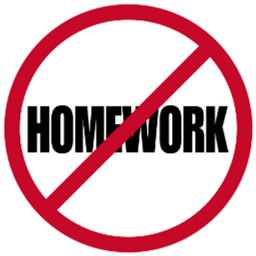More, More, More

October 9, 2015
The sun crawls through the blinds, the bars of your prison, and reminds you that there is a world outside of homework, one where you can catch up on that latest TV show or that new game console you received for your birthday. You flick your eyes back to your essay, your math problems, your social studies report, your science fair project, and remind yourself that you are almost done. All the light is gone and there are only a few minutes separating Tuesday and Wednesday but you still have an essay to write and a science fair project to work on. But how will you get it all done? This is the question students across America and around the world ask themselves every day. But is homework the maker of good students and good grades we tout it to be? Researchers agree that students receive too much homework, that this homework is ineffective, that it teaches students to despise learning and that it only strains the lives of students and their families.
No one can deny the importance of homework to continuing learning beyond the classroom and sharpening students’ skills. However, what is the limit? How much is too much homework? The National Parent Teacher Association (PTA) and National Education Association (NEA) recommend the “10 minute rule” of easing students into the homework onslaught. First-graders should receive 10 minutes of homework, second-graders 20, third-graders 30 and so on until students reach high school age and have the need and appreciation for homework. But schools are ignoring these powerful guidelines. Kindergarteners, the same sleepy little children only recommended to spend 10 minutes on homework, spend 25 minutes a day on homework. These unfortunate statistics snowball from year to year to year until high school is a sick symphony of essays, posters, worksheets, problems, PowerPoints, Prezi’s, reports, studying – can I take a breath? Pumping elementary school students with upwards of three times as much homework as experts recommend only plants the seed of hate students have for school.
However, the amount of homework is not the only problem. It is the type of homework that schools need to reevaluate. As Dr. Donna W. Jorgensen says “homework [is] an exercise in futility if students do not know the purpose of the homework.” Drilling students with ten iterations of the same type of problem does not foster their skills but teaches them the tedium of school. Repetitious and unfocused homework bores kids but studies show that problems and projects may not be the answer to learning at all. Stanford University education professor Denis Pope and the Toronto Star agree that the only type of homework that benefits kids is reading. Both the amount of homework and type of homework are futile to a student’s growth and success.
The only thing homework has been proved to grow is stress and strife. As Whit Honea, dad and author of The Parents’ Phase Book, said “when you’ve spent eight hours at work and they’ve [students] spent six hours at school, the last thing you want to do is be fighting with them for two hours about a meaningless piece of paper.” Homework is just a constant stress for students overwhelmed by the pressure to succeed, compete with their peers and make the grades they need to get into college. It is the primary source of arguments and disruptions to a strong family according to many researchers. The bulk of students run to their parents for assistance because they do not have the time to spend too long on any one assignment with the sheer number of them, not to mention the extracurricular activities they juggle. I find myself trading the time to understand for the quick answers I need to succeed. I call on my father or brother to work me through my math problems because I need to move on to an essay or poster or PowerPoint or cram for my Spanish test. My parents, like Honea, then trade the family time students need to grow and explore for the all-day work schedule they should not have to experience until they enter the work force like their parents. Honea found that his son’s homework was only breaking his spirit and inspiring attitude, a recurring story I remember having with my family as we struggle to drill math problems into my head or teach my brother how to write. International researchers Mike Horsley and Richard Walker found this recurring case of “detrimental” homework in their 2012 study. The drill and practice work breaking down student’s zest for learning and its sheer amount do not “significantly impact achievement,” more often taking the form that Honea or my parents see when students abandon the educational system just as it has abandoned them.
The leaves are changing, the humid summer is melting, school is starting back up and students like me are hit with the familiar and pungent scent of homework, yet another year of trading sleep and free time and creativity and family time for backbreaking work – literally. The American Association of Orthopedic Surgeons (AAOS) even concluded once that “that thousands of kids have back, neck, and shoulder pain caused by their heavy backpacks.” Teachers and parents often mistake homework for success, for rigorous schooling. However, homework is not a constant in the equation of academic success. More homework does not equal better grades, higher test scores or higher intelligence. All it guarantees, in its current levels, is the destruction of creativity, excitement for learning and students’ home lives. But is homework more helpful than it is harmful? In an age where school is everything to kids, the maker of success, the ticket to college and the motivator of cheating, the dizzying amounts of homework piling up on student’s desks is not the answer to relieving the stress of the nation. The pressure is building for students to achieve more, more, more and it cannot go on without a release.



